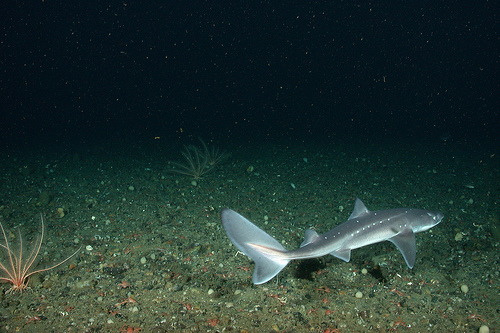You will not see as many shark individuals as the spiny dogfish, in a single place.
- Spiny dogfish is a species of small shark, found in waters of 5 to 15 degrees Celsius (41 to 59 degrees Fahrenheit), in predominantly coastal areas of oceans across most of the earth.
- ‘Spiny dogfish’ is also known as ‘mud shark’, ‘thorndog’, ‘spurdog’, ‘Pacific dogfish’, ‘piked dogfish’, ‘cape shark’ and ‘cogshark’.
- The scientific name of the spiny dogfish is Squalus acanthias and it is from the family Squalidae, the family of dogfish sharks.
- Spiny dogfish typically grow to be 0.8 to 1.24 metres (2.6 to 4 feet) in length, although they may grow as long as 1.6 metres (5.2 feet).
- Spiny dogfish are generally of a grey to brown colour, frequently with white spots, and they have a white or light grey belly.
Spiny Dogfish
Image courtesy of NOAA’s National Ocean Service/Flickr
- The diet of a spiny dogfish consists primarily of smaller fish, including sharks and their eggs, as well as squid, crab and octopus.
- Spiny dogfish have a pair of dorsal fins (on the back), one smaller than the other, but both having spines; and the sharks may form schools that can contain over a thousand individuals.
- Although spiny dogfish are now considered vulnerable due to over-fishing, they were once one of the most plentiful sharks in the world’s oceans.
- Eggs of spiny dogfish females hatch inside the shark, and after approximately two years, the female shark gives birth to live ‘pups’, generally numbering between two and eleven.
- Spiny dogfish are caught and eaten as commercial fish, particularly in Europe, and they are also used to produce oil and fertiliser.
Bibliography:
Spiny Dogfish, 2016, A-Z Animals, http://a-z-animals.com/animals/spiny-dogfish/
Spiny Dogfish, 2016, Wikipedia, https://en.wikipedia.org/wiki/Spiny_dogfish
Fordham S, Fowler S, Coelho R, Goldman K & Francis M, Squalus acanthias, 2006, The IUCN Red List of Threatened Species, http://www.iucnredlist.org/details/summary/39326/0
Street R, Squalus Acanthias, Animal Diversity Web, http://animaldiversity.org/accounts/Squalus_acanthias/








